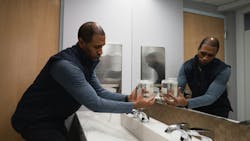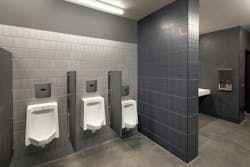Smarter Restrooms, Lower Costs: How Facilities Stay Ahead of Maintenance and Sustainability Demands
Key Highlights
- IoT platforms enable predictive maintenance, real-time diagnostics, and usage analytics, reducing response times and operational disruptions
- Smart fixtures can be remotely monitored and configured via smartphone apps, allowing facility teams to troubleshoot and optimize performance efficiently
- Adopting integrated restroom solutions supports sustainability goals, enhances user satisfaction, and delivers measurable operational benefits
Managing commercial restrooms presents unique challenges that can make or break a facility's reputation. From unexpected maintenance emergencies to rising sustainability demands, contractors and facility managers face mounting pressure to deliver exceptional performance while controlling costs. The solution lies in embracing innovative technologies that simplify operations and enhance efficiency.
The Triple Challenge
Commercial restroom management involves three critical areas that directly impact operational success.
Maintenance Headaches
Reactive maintenance drains budgets and disrupts operations. For example, traditional flushometers can handle 250,000 flushes during their lifecycle, but in high-traffic facilities processing 4,000 flushes monthly, this translates to just five years of service. Maintenance teams spend countless hours responding to leaks, clogs, and equipment failures instead of preventing them.
Manual inspections consume valuable time and often miss early warning signs. Staff must physically check each fixture, document issues, and coordinate repairs across multiple locations. This reactive approach leads to water waste, user complaints, and unexpected downtime.
Sustainability Pressures
As water conservation regulations tighten while utility costs rise, facilities must reduce consumption without compromising performance or user experience. Traditional systems lack visibility into water usage patterns, making optimization difficult.
Energy efficiency requirements add another layer of complexity. Battery-powered fixtures need regular replacement, while hardwired systems require electrical infrastructure modifications. Balancing sustainability goals with operational efficiency has become increasingly challenging.
User Expectations
Today's users expect reliable, hygienic restroom experiences. Inconsistent flush performance, empty soap dispensers, or broken fixtures damage facility reputations and user satisfaction scores. Meeting these expectations requires proactive management and rapid issue resolution.
Solutions That Transform Operations
Advanced technologies address the challenges above by providing visibility, automation, and preventive capabilities that revolutionize restroom management.
IoT Systems
Internet of Things (IoT) platforms transform maintenance from reactive to predictive. Connected fixtures collect real-time data on usage patterns, performance metrics, and potential issues. This intelligence enables maintenance scheduling based on actual activations rather than arbitrary timelines.
IoT systems provide remote diagnostics and troubleshooting capabilities that technical teams can use to instantly identify problems and create solutions using smartphone connectivity for one-to-one communication with smart products or using Ethernet, Wi-Fi, or LTE Cellular connectivity for facility-wide one-to-many communication with smart products. This approach reduces response times and minimizes facility disruptions.
Usage analytics also reveal traffic patterns that optimize maintenance scheduling. Facilities can plan service activities during low-traffic periods, reducing user impact while maximizing efficiency.
Top-fill Soap Dispensers
Traditional soap dispensers require maintenance staff to work under sinks, creating safety risks and inefficiencies. Top-fill systems eliminate these concerns by allowing refills from above the counter.
In addition, advanced top-fill soap dispensers feature a patented level-sensing design with on-spout indicator lights. This system prevents overflow while still ensuring complete soap utilization. Maintenance teams can quickly top off dispensers. The locking closed system prevents bacteria and germs from contaminating soap and once attached allows hands free refills and automatic shut off when soap dispenser is full preventing overflow spills on sink decks and floors.
Pressure-assist Technology
High-traffic facilities face constant clogging issues that disrupt operations and frustrate users. Pressure-assisted toilet systems deliver powerful flush performance that prevents blockages and reduces maintenance interventions.
These systems use pressurized air to enhance water velocity and cleaning power. The result is reliable operation even in demanding environments like stadiums, airports, educational facilities, and more.
Results on a Grand Stage
Commercial facilities across the country are beginning to put these next-generation solutions into practice. One example is The Astro and The Astro Amphitheater, Nebraska’s first indoor-outdoor multipurpose event venues that bring world-class entertainment to the local community. With such large spaces that host thousands of people each week, the facility maintenance team at The Astro knew it needed to specify restroom products that are dependable, sustainable, and visually pleasing.
As a result, The Astro chose to install sinks paired with deck-mounted faucets and soap dispensers to provide visitors with an integrated handwashing experience and optimize traffic flow. The collection of touch-free products makes life simple for The Astro’s maintenance team by reducing the time to install, service, and maintain by 50% or more, and facility managers can easily check the status of the fixtures and configure the Bluetooth-connected faucets and flushometers using an app on their smartphones. The app enables the facility team to troubleshoot issues, shorten repair time, reduce risk, and lower costs.
The Path Forward
Successful facility management requires embracing technologies that simplify operations while enhancing performance. IoT-enabled systems, innovative dispensing solutions, and expert support help transform challenging maintenance scenarios into manageable operations.
Sloan's commitment to advancing restroom technology spans nearly 120 years. The company's comprehensive approach addresses every aspect of facility management through integrated solutions like the SC Argus Pro, an IoT system that provides two-way communication with connected fixtures, enabling remote adjustments and comprehensive reporting. The system allows maintenance teams to access customizable analytics that support data-driven decision making.
In addition, Sloan's top-fill soap dispensers represent thoughtful design that prioritizes maintenance efficiency. The closed-system architecture prevents contamination while level-sensing technology eliminates guesswork and waste.
Integrated commercial restroom solutions that address maintenance, sustainability, and user satisfaction deliver measurable results that not only justify investment but support long-term success—providing facility maintenance teams with peace of mind to focus on other critical tasks on their to-do lists.
About the Author
Morgan Kish
Morgan Kish is director of product management at Sloan, where she is responsible for Sloan’s faucet and soap dispenser product categories.

